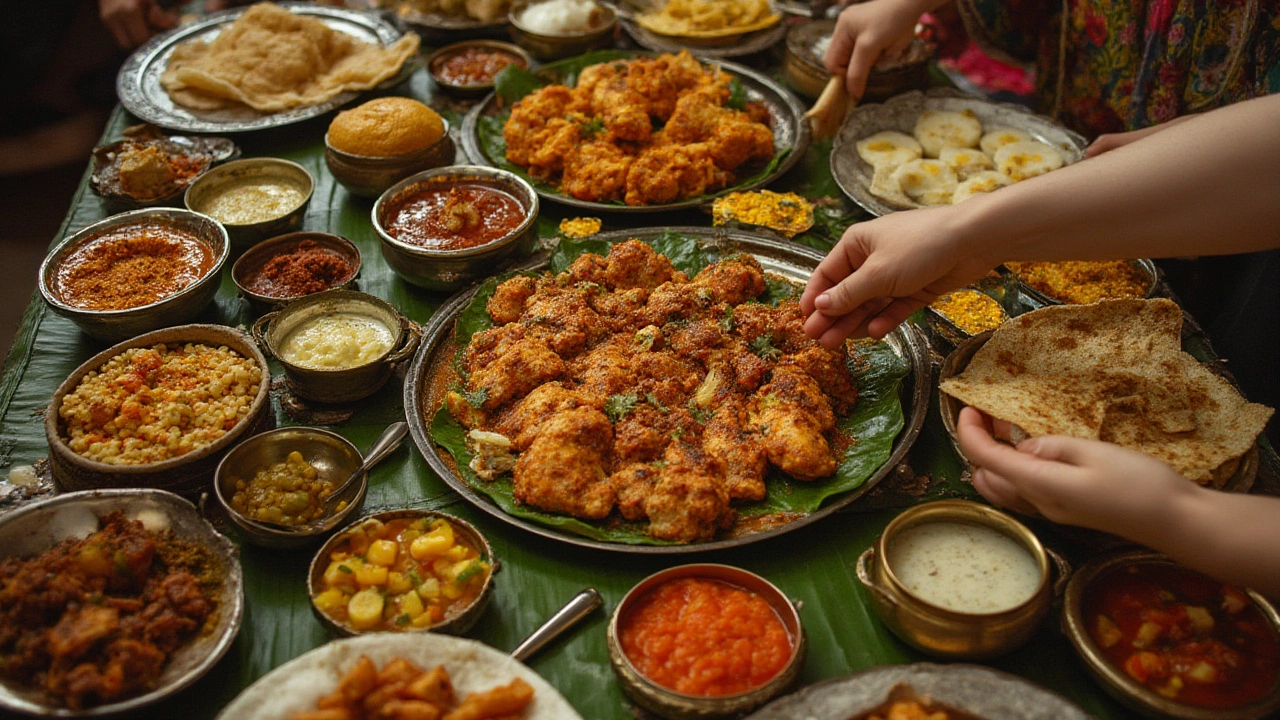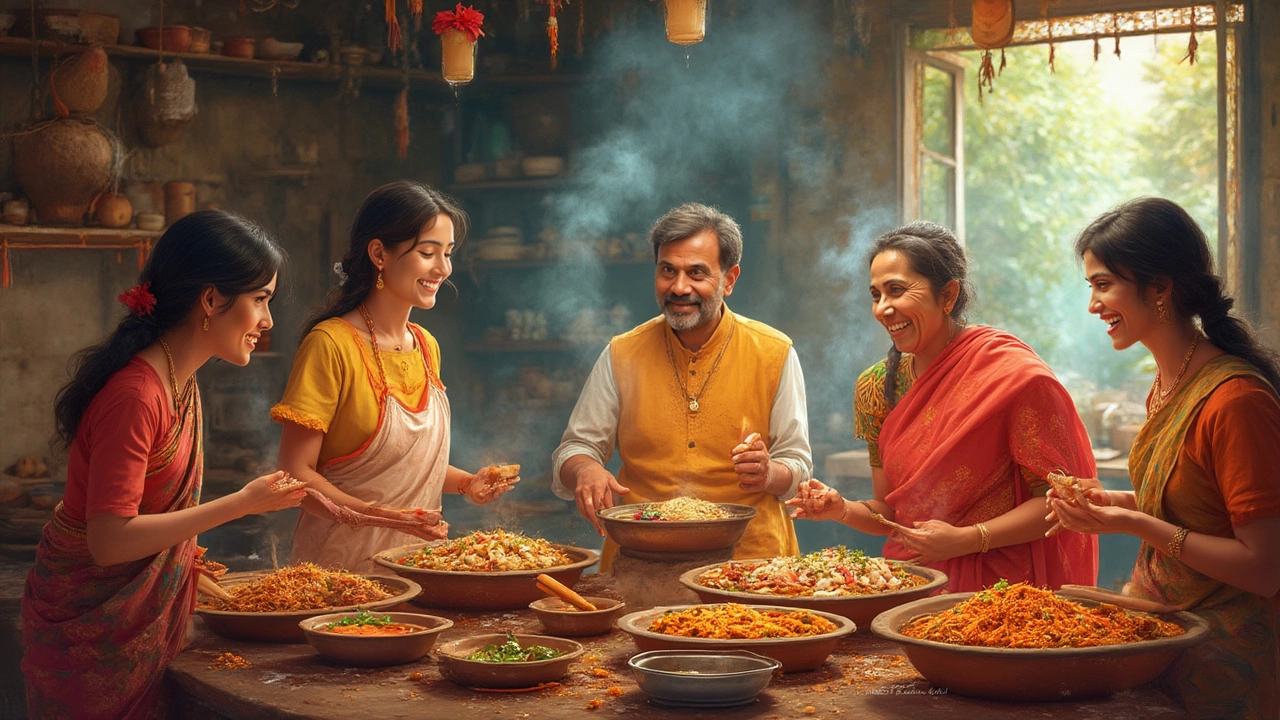Imagine food that makes your taste buds jump between sweet, spicy, tangy, and earthy—all in one bite. That's Indian food for you. A single meal can take you on a journey—from the smoky aroma of tandoor-grilled meats to the creamy comfort of a slow-cooked dal. If you think Indian food is just ‘curry’ or always spicy, you’re about to have your mind changed. The truth is, Indian food is a world of contrasts and layers, shaped by centuries of tradition, invasions, trade, and celebration.
The Many Faces of Indian Cuisine
So, what kind of food is Indian food? It’s not just one “thing” at all. India is more like a continent than a country when it comes to food—it’s home to over 1.4 billion people, more than 100 spoken languages, and climates ranging from snow-capped Himalayas to sunbaked deserts to lush coasts. Naturally, what people grow and eat changes dramatically from north to south, east to west. In Punjab, wheat fields and dairy farms turn out rich breads (like naan and paratha), creamy paneer dishes, and frothy lassi. Go down south, and the heat brings coconut, rice, tangy tamarind, and spicy sambar to every meal. The east loves its fish and sweet treats—think Bengali rasgulla—while the west pours spices into street food like chaat and classics like Goan fish curry.
Even the definition of “curry” isn’t as simple as it sounds. That word was actually popularized by the British. In India, each gravy has its own name and character: butter chicken’s sauce is creamy and mellow, vindaloo is fiery and vinegary, kadai goes heavy on tomatoes and peppers. And then you have dry dishes that never see a drop of sauce, like tandoori chicken—marinated in yogurt and roasted at searing temperatures—or crispy dosas, which are like savory crepes.
There’s a logic to what goes on one plate too. Many eat with their hands, scooping up gravies with bread or rice, always matching flavors that balance each other: something rich is paired with something sharp or cooling, like lime pickle or raita.
Spices are the backbone, but few Indian home cooks make food that’s “super hot.” Instead, they blend spices—cumin, coriander, turmeric, and more—for aroma and depth. A classic study by IIT Jodhpur found that Indian recipes use negative flavor pairing: combining ingredients with less overlap of flavor molecules, which creates complexity. That’s different from, say, French or Western cooking, which often pairs similar flavors together.
All this doesn’t come from nowhere. Indian food reflects geography, seasons, past invaders (Persian, Portuguese, British), festivals, religion (many don’t eat beef or pork; a huge segment is vegetarian), and also, just what’s fresh and nearby. Each dish tells a story of migration, family secrets, and local ingenuity.
What Makes Indian Food Stand Out?
If you ask any chef or home cook, they’ll say—Indian food is all about the “tadka,” the layering of flavors and the transformation that happens in the pan. Even a basic dal (lentil soup) changes when you pour a sizzling mix of ghee, cumin seeds, garlic, and chili oil over it at the end. The aroma bursts out, flavor deepens, and what could have been plain gets a punch of character.
Another key thing: Indian food rarely uses processed ingredients. Whether it’s grinding spices fresh every day or fermenting rice and lentils for dosa batter, traditional Indian kitchens are about patience, and time is treated as an ingredient. Even street foods like samosas or pani puri involve multiple steps and layers.
Here’s a fun fact: India uses more pulses—lentils, beans, chickpeas—than almost any country. That’s why you’ll see dishes like dal, chana masala, rajma, and sambar everywhere. This makes Indian food naturally rich in protein, even for vegetarians. In fact, nearly 40% of Indians follow a vegetarian diet, according to a 2021 Pew Research Center report. No wonder you get entire menus with just paneer, potatoes, or lentils, looking and tasting like a feast.
And let’s talk about the breads. Roti, naan, puri, bhatura, appam—just the variety in breads deserves an entire chapter. North Indian breads are mostly wheat-based and sometimes stuffed (think aloo paratha with spicy mashed potatoes), while southern and eastern regions lean more towards rice-based or fermented options.
Chutneys are another signature. They can be sweet (made with mango or dates), spicy (green chilies and cilantro), tangy (tomato or tamarind)—and often, all in the same meal. These aren’t tacked-on condiments; they’re essential to the Indian eating experience, balancing out or highlighting a main dish.
| Key Ingredient | Purpose | Regional Preference |
|---|---|---|
| Rice | Staple Grain | South, East |
| Wheat | Bread, Roti | North, West |
| Pulses (Lentils, Beans) | Protein Source | Pan-India |
| Coriander | Flavor & Garnish | Pan-India |
| Ghee | Fat, Aroma | North, West |
| Coconut | Thickener, Flavor | South, West Coast |
Now, about the mix of vegetarian and non-vegetarian options. While states like Gujarat and Tamil Nadu are mostly vegetarian, Bengal, Kerala, and Goa celebrate their fish and seafood. Up in the north, kebabs and tandoori meats are the stars. There’s truly something for every palate.

Popular Dishes and Where They Come From
This country’s food scene is a mix of ancient recipes and modern creativity. Some dishes have been around for centuries, while others are reinventions born in cities and on street corners. Still, if you’re looking for a crash course, here are a few essentials and the regions they’re tied to:
- Butter Chicken—Delhi/Punjab: Rich, creamy, and laced with tomato, this is probably the most famous export. It’s often paired with naan.
- Dosa—South India: Thin, crispy, and made from fermented rice and lentil batter, dosas are served with sambar (a lentil stew) and coconut chutney.
- Biryani—Hyderabad, Lucknow, Kolkata: This is not your regular ‘fried rice’. Biryani is rice and meat layered and slow-cooked with saffron. Each city has its signature style.
- Paani Puri—Mumbai/West India: Wheat or semolina shells filled with spicy water, potatoes, and tangy chutney. A favorite roadside snack.
- Rogan Josh—Kashmir: Lamb cooked till tender in a red, aromatic sauce made from Kashmiri chilies and yogurt.
- Fish Curry—Bengal, Kerala, Goa: Each region has its take—Bengalis love mustard, Kerala uses coconut, Goans like it spicy and tangy.
- Paneer Tikka—North India: Chunks of cheese marinated in spices, roasted on skewers.
- Chaat—Delhi, Kolkata: A mix of crispy, tangy, spicy components—potatoes, chickpeas, chutneys, sev.
- Idli—South India: Steamed rice-and-lentil cakes, served with sambar and chutney. A staple breakfast.
- Dhokla—Gujarat: Spongy cakes made from fermented chickpea flour, steamed and topped with mustard seeds.
And sweets—where to start? Kulfi (like Indian ice cream), jalebi (crispy sugar spirals), gulab jamun (fried, syrup-soaked dough balls), and rasgulla (chewy cheese balls in syrup). India is the world’s biggest producer—and consumer—of sugar, so expect a lot of options when it comes to desserts.
What makes this even more exciting is how every home puts its spin on these classics. Ask for “masala chai” at roadside stalls, and you’ll get a totally different mix of spices depending on the state, maybe even the shop!
And then there’s fusion. Urban India loves tweaking traditional recipes—pasta with paneer tikka sauce, pizzas topped with tandoori chicken, even chocolate samosas. It’s tradition and innovation, all on the same menu.
Taste Indian Food at Home: Tips, Tricks, and First Steps
Ready to try making Indian food? Don’t get overwhelmed by the list of spices. Start small. A well-stocked beginner’s spice shelf has cumin, coriander powder, turmeric, red chili powder, and garam masala. You can find pre-ground ‘masala’ blends at most grocery stores, but as any Indian granny will tell you, fresh is always better.
The magic happens with layering. For most dishes, you’ll start by frying spices in oil or ghee, followed by onions, then tomatoes, ginger, and garlic. Only after that do you add in the main ingredient—lentils, chicken, paneer, or vegetables. Let it cook, add water, and adjust seasoning. Simple. For bread, start with roti or paratha, as they’re less complicated than naan or appam, which need fermentation and practice.
If you’re new to Indian rice dishes, try a basic pulao before moving up to biryani. Basmati rice is key—its long grains and aroma make all the difference. Just rinsing the rice a few times and then soaking it for 20 minutes makes it fluffier, a trick straight from Indian kitchens.
Want to try your hand at a chutney? Blend fresh coriander, mint, green chili, and lemon juice with a pinch of salt for a quick, refreshing green chutney. Or mix yogurt with roasted cumin and salt for a cooling raita.
If you’re eating out, ask for your food mild, medium, or hot—most restaurants will happily adjust the spice level. Remember, not every dish is ‘fiery.’ Trust your taste, and be ready for new textures, subtle flavors, and unexpected combinations.
And here’s a tip: The best Indian food is often at homes, small “dhabas” (roadside eateries), or hole-in-the-wall places with loyal crowds. Don't just chase after big names—follow the locals (or, if you can, find an Indian friend whose home you can visit for a meal).
Now, for vegetarians and vegans—India is your playground. Almost every city has entire restaurants serving only vegetarian food. And if you avoid dairy, just say “no ghee, no paneer”—chefs get it.
So, if anyone asks, “What kind of food is Indian food?”—you now know it’s not one thing, but a universe of flavors, stories, and traditions. Wherever you start, you’ll never run out of new dishes to try—or ways to be surprised by the incredible world of Indian cuisine.
